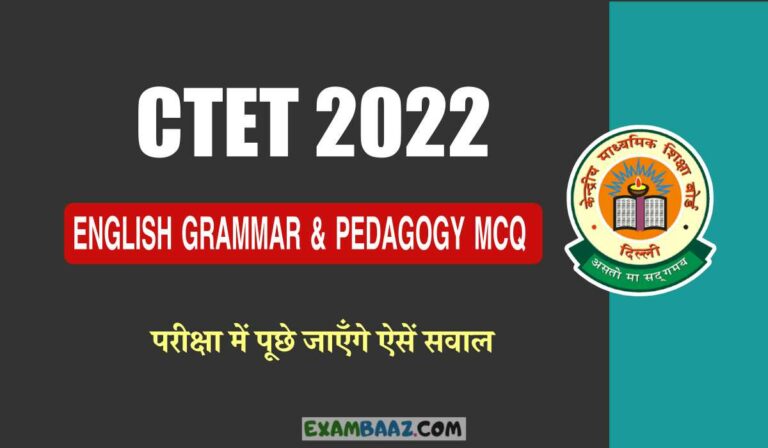CTET Exam 2022 English Grammar And Pedagogy Practice Test: केंद्रीय माध्यमिक शिक्षा बोर्ड (CBSE) द्वारा सीटेट परीक्षा का शॉर्ट नोटिफिकेशन जारी कर दिया गया है, अब ये परीक्षा दिसंबर माह में आयोजित की जाएगी। नवीनतम प्राप्त जानकारी के अनुसार बोर्ड द्वारा जल्द ही सीटेट परीक्षा के आवेदन प्रक्रिया प्रारंभ की जाएगी। यदि आप भी शिक्षक बनने के लिए सीटेट परीक्षा की तैयारी कर रहे हैं तो इस आर्टिकल में दी गई जानकारी आपके लिए बेहद महत्वपूर्ण है।
सीटेट परीक्षा की तैयारी कर रहे अभ्यर्थियों के लिए हम रोजाना CTET पेपर 1 पेपर 2 के सभी महत्वपूर्ण विषयों के प्रैक्टिस सेट उपलब्ध करा रहे हैं। इसी श्रंखला में आज हम English Grammar & Pedagogy के कुछ महत्वपूर्ण सवाल शेअर कर रहे है जो आपको CTET परीक्षा की तैयारी में काम आ सकते है।
CTET EXAM 2022 ENGLISH GRAMMAR & PEDAGOGY MCQ Test
1. ‘What is realia’?
(a) Using objects like toys, pictures and painting to brainstorm learners to a speaking activity
(b) Using reality shows for teaching-learning of language and specific language functions.
(c) Any materials like texts and narratives and actions.
(d) All the teaching aids advocated by educational agencies and schools,
Ans- a
2. Competency based language assessment aims at —————-.
(a) enabling learners to master the language in terms of accuracy.
(b) enabling learners to perform language in social and professional situations.
(c) enabling learners to secure high scores in high stake examinations.
(d) enabling learners to use language through memorization.
Ans- b
3. Which two of the following are the major purposes of school-based assessment?
(A) It promotes teacher’s and learner’s autonomy
(B) It gives an opportunity for the school to plan on their own.
(C) It makes the school aware the examination board’s power.
(D) It reduces the quality of learning in school. A and D
(a) A and D
(b) B and C
(c) C and D
(d) A and B
Ans- d
4. A learner uses key words to construct schema of the discourse and infers the setting for a text while listening. Which listening strategy does he adopt?
(a) Top-down strategies.
(b) Both top-down and bottom-up strategies.
(c) Neither bottom-up nor top-down strategies
(d) Bottom-up strategies
Ans- a
5. Words that we have learned to use in different contexts are known as ————-
(a) Active vocabulary
(b) Collocations
(c) Passive vocabulary
(d) Action words
Ans- a
6. Which one of the following is NOT a poetic device?
(a) Simile
(b) Image
(c) Metaphor
(d) Appreciation
Ans- b
7. Sumi Chang moves from Aizawl to Mysore due to her father’s transfer of job. She learns the language of the place, Kannada very well. How do you describe this?
(a) Language learning
(b) Language acquisition
(c) Language transfer
(d) Language intervention
Ans- b
8. Which of the following is NOT true of learning outcomes?
(a) Learning outcomes need to align with the learning objectives.
(b) Learning outcomes are much more than learning objectives
(c) Learning objectives are less than the learning outcomes
(d) Learning outcomes has no relationship with objectives
Ans- d
9. What does ‘innateness’ refer to in language acquisition?
(a) The natural ability of humans to speak a language.
(b) The ability of the learners to learn many languages.
(c) The ability of the learners in school to code switch from one language to another.
(d)The ability of humans to think in a language.
Ans- b
10. Translanguaging is —————
(a) Teaching-learning of many languages in one classroom.
(b) Using the (many) languages of learners to teach- learn content and languages.
(c) Making the learners learn many languages to become multilingual.
(d)Transferring children from one language to another through bilingual teaching.
Ans- a
11. What is the place accorded to Hindi in the Indian Constitution?
(a) Language of judiciary
(b) National language
(c) Official language
(d) Language of education
Ans- c
12. Raghav reads a land document to find out the location of the land and its survey number. What is this reading known as?
(a) Scanning
(b) Skimming
(c) Reading for purpose.
(d) Reading for information.
Ans- a
13. The idea of universal grammar as a set of rules in the human mind was postulated by –
(a) B.F. Skinner
(b) Watson
(c) Lev Vygotsky
(d) Noam Chomsky
Ans- d
14. Zone of proximal development refers to –
(a) The part of the brain which deals with language development.
(b) The gap between child’s actual development and what he can do with someone’s help
(c)The fluency in language which child acquires when he reaches adolescence
(d) The difference in proficiency of language acquisition between two children
Ans- b
15. Talking to children to help them develop their oral language is an important component of
(a) Process writing approach
(b) Intensive reading
(c) Product writing approach
(d) Emergent literacy
Ans- d
ये भी पढ़ें-
